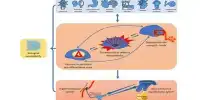Identifying early signs that may help predict the risk of attention-deficit/hyperactivity disorder (ADHD) in children can be difficult, because the diagnosis is usually made based on the presence of persistent and impairing symptoms that last for at least six months.
According to new research from RCSI University of Medicine and Health Sciences, information available at birth may help identify children who are more likely to develop ADHD. The study, published in Development and Psychopathology, looked at data from nearly 10,000 children in the United States and discovered that information about pregnancy and birth can help predict the severity of ADHD symptoms in children.
The Adolescent Brain Cognitive Development (ABCD) study is an ongoing study of children born between 2005 and 2009 in the United States. Children were enrolled in the study between the ages of 9 and 10, and their parents were questioned about the pregnancy and birth, as well as their child’s current mental health.
We know that certain events during our time in the womb can have long-lasting consequences for our health. But not many studies have tried to quantify just how useful prenatal information could be to predicting childhood ADHD symptoms.
Dr. Niamh Dooley
The RCSI researchers identified 40 factors that would normally be known at birth, such as the baby’s gender, the age of the parents, any complications during pregnancy or delivery, and the baby’s exposure to factors such as cigarette smoke in the womb. The researchers discovered that 17 of the 40 factors were particularly good at predicting the number of ADHD symptoms in childhood using machine learning and statistical techniques.
Co-lead researcher, Dr. Niamh Dooley from the RCSI Department of Psychiatry, explained that few studies to date have looked at how prenatal and birth information could be useful in predicting ADHD: “We know that certain events during our time in the womb can have long-lasting consequences for our health. But not many studies have tried to quantify just how useful prenatal information could be to predicting childhood ADHD symptoms. We focused on readily available information about pregnancies and births, the kind that would be in antenatal records. This ensures our results can be compared to other studies using medical records and that they are relevant to public health.

“Another important aspect of this study was acknowledging the role of social, economic, and demographic factors in maternal and child health.” Dr. Dooley explained that “prenatal information did not predict ADHD symptoms equally across the sexes, family income brackets, or racial/ethnic groups.”
“While we only explained up to 10% of the variation in childhood ADHD symptoms, this was with information typically available at birth,” said Professor Mary Cannon, Professor of Psychiatric Epidemiology and Youth Mental Health at RCSI and study co-lead. We cannot predict who will develop ADHD in childhood based solely on birth information, but it may help identify which children require the most support, especially when combined with other factors such as genetics, family history, and the early life environment.
“In our study, mothers were asked about their child’s pregnancy and birth 9-10 years prior. The next step would be to conduct a study in a group that has been tracked in real-time throughout pregnancy, birth, and childhood. This would increase our trust in prenatal information and our belief that it can help identify children at risk of developing ADHD at an early age.”
The study found that being male, as well as exposure to factors in the womb such as cigarette smoke, recreational drugs, and the mother having urinary tract infections or low iron levels, were useful in predicting ADHD symptoms in childhood.















